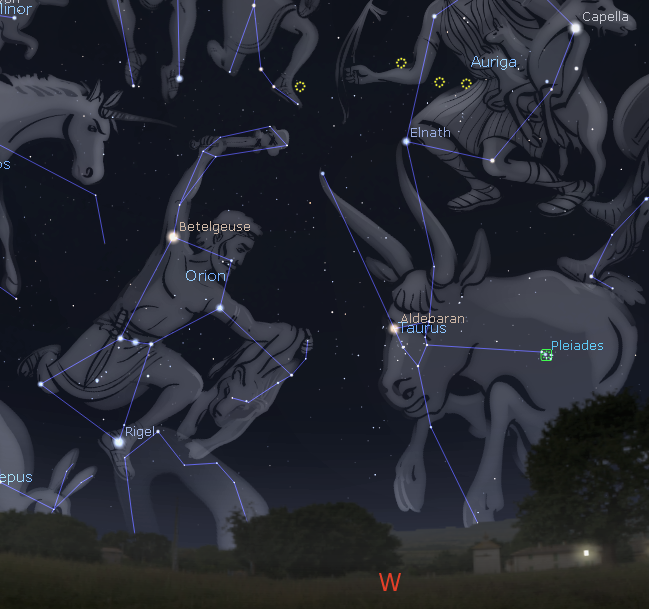This Week’s Sky at a Glance, 2022 April 9 – 16 ~by Curt Nason
In April we can start a long goodbye with the winter constellations. Orion and Taurus are setting together, which makes it easier to imagine their eternal battle. The bull is protecting the Pleiades (Seven Sisters) from the amorous advances of Orion, who is about to strike a downward blow to the bull’s head with his upraised club. The bull’s long horns, one tip of which is the bottom left star of Auriga (Elnath – officially the second brightest star of Taurus), are not to be taken lightly. It is difficult to tell which of the two combatants is more dangerous.
The winter constellations of Auriga and Gemini are still up past midnight but Rigel, in the knee of Orion and the low point of the Winter Circlet of bright stars, is setting around 10:30 pm. With the Pleiades sinking in the western twilight, through a thicker layer of our atmosphere, they will twinkle more. I have a pleasant memory of seeing them with binoculars when they were low in the west, flickering wildly like candles on a birthday cake. I had the urge to make a wish and blow them out. Mercury will be passing near the Pleiades near month’s end to enhance the binocular view.
This Week in the Solar System
Saturday’s sunrise in Moncton is at 6:43 am and sunset will occur at 7:58 pm, giving 13 hours, 15 minutes of daylight (6:49 am and 8:02 pm in Saint John). Next Saturday the Sun will rise at 6:31 am and set at 8:07 pm, giving 13 hours, 36 minutes of daylight (6:37 am and 8:11 pm in Saint John).
The Moon is at first quarter on Saturday and full next Saturday. On Tuesday Jupiter rises 55 minutes before the Sun but bright twilight will make it very difficult to see Neptune just below it with a telescope. Venus, Mars and Saturn are stretched out 10 to 25 degrees to the west of Jupiter. Mercury has popped up into the evening sky after last weekend’s conjunction, setting 50 minutes after sunset on Tuesday. The steep angle if the ecliptic on spring evenings places Mercury higher than usual making it easier to locate, especially with binoculars at first.
On Sunday evening at 8 pm, tune in to the Sunday Night Astronomy Show via the Facebook page or YouTube channel of Astronomy by the Bay.
Questions? Contact Curt Nason.

